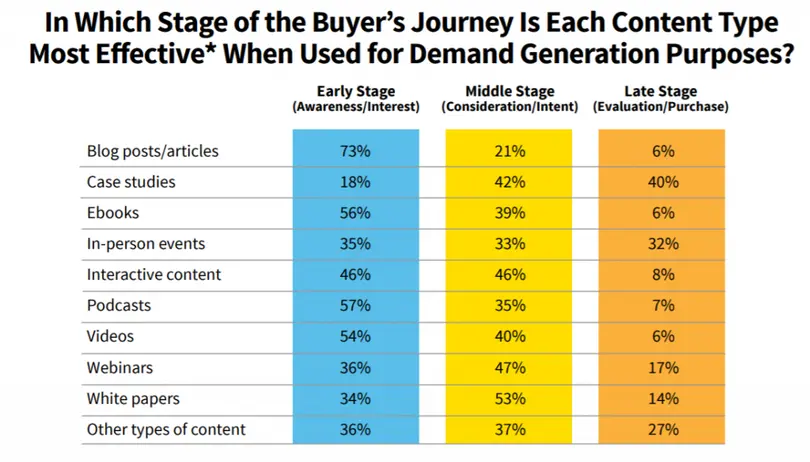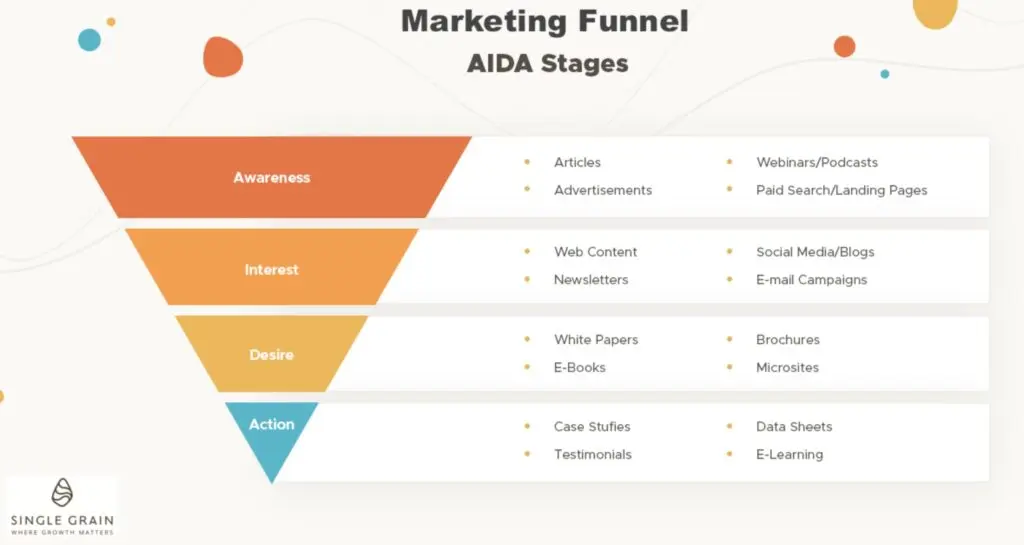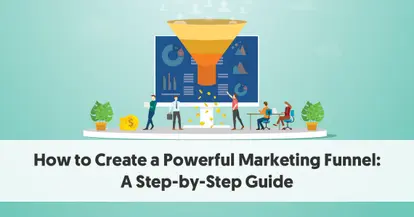It can be really frustrating when you try your best to reach your target customers but have nothing to show for it. One of the reasons could be that your marketing initiatives lack a plan or structure.
That is exactly what marketing funnels can offer you—a structure.
In this post, we will discuss the importance of marketing funnels along with a step-by-step guide to create one. You can use this as your reference when creating marketing funnels for your business.
Why Do You Need a Marketing Funnel?
Marketing funnels help you map a buyer’s journey into different stages. Then you can plan marketing strategies to target buyers at each stage. This helps organise your marketing efforts in a much more focused way in order to deliver the best results.
This helps you reach the right people, with the right marketing tactics, at the right times.
Marketing funnels can help you save time, money, and effort by making your initiatives more focused and targeted. Therefore, it is a good idea to use funnels to improve your marketing ROI.
Another benefit of using marketing funnels is as simple as the fact that they work. Marketers, worldwide, can vouch for the effectiveness of using marketing funnels to get more conversions. They can help you attract and convert more customers by directing relevant leads down the funnel.
Now you know how important marketing funnels are and how they can help you get the best marketing ROI. Now, the only thing that remains is to actually create a funnel and see the results first-hand.
Here is a three-step guide to creating a marketing funnel for your business.
How to Create a Powerful Marketing Funnel: A Step-by-Step Guide:
1. Understand Your Audience
The first step in building a marketing funnel is to understand your target audience. You need to know who you want to target before you can create a marketing funnel to target and convert them into customers.
There are several ways in which you can understand your target customers. These include direct feedback from your existing customers, surveys, social media, and web analytics data.
The idea is to not only understand who your target customers are but also how they interact with your website and content. Their online behaviours will help you understand how to shape your funnel and what stages to add.
For example, you might have a website that gets most of its traffic on your blog. Now, your goal is to direct this traffic to the product or service pages. This means that the blog will be a top-of-the-funnel marketing tactic for you and CRO (conversion rate optimisation) can be the next stage.
So the first step in building a marketing funnel is to understand how your customers behave online and interact with your website so that you can form a buyer journey map.
2. Determine the Number of Stages in Your Funnel
Once you understand a typical buyer’s journey before purchasing your products, then you can determine the different stages in your funnel. A marketing funnel, after all, is just a way to direct more people in the right direction on their journey. Therefore, your buyers’ journey map will be the basis for forming the stages of your marketing funnel.
However, to explain things in the simplest manner, let’s consider the simple three-stage marketing funnel. Here are the three basic stages of most marketing funnels:
Awareness and Interest (Top)
The goal at this stage is to reach more people and make them aware of your brand and products and evoke their interest. Some marketers like to break this into two stages to have a more precise and targeted funnel.
The first time a consumer hears about your brand forms the first impression. You need to get as many consumers at this stage as possible because the number will keep decreasing as they move down the funnel.
Desire (Middle)
This is the next stage where the consumer already knows about your brand, is interested, but is not sure whether or not to make a purchase. This is the stage where you need to convince your prospects that your products are better than the alternatives.
The marketing tactics at this stage aim to inform the prospective customer about the value that you provide and what makes you unique. If they develop purchase intent, they will move to the next stage. If not, they will simply leave.
Action (Bottom)
This is the final stage of the funnel where the prospect already has purchase intent and you just have to close the deal. This is where you need to put the final nail in the coffin and ensure that your prospects end up making a purchase.
3. Add Marketing Tactics to Each stage
Once you have determined the stages in your marketing funnel, the next step is to figure out which marketing tactics to use at each stage. Remember, you can build a marketing funnel as long or short as you think fit, depending on your target customers. And, after you do that, you can then start thinking about each stage in more detail.
Here are some of the most popular marketing tactics used at different stages of a marketing funnel. For the sake of simplicity, we have considered a basic three-stage funnel.
Top-of-the-Funnel
The popular marketing strategies for this stage include:
- Social media marketing aimed at increasing social traffic to your website.
- Influencer marketing campaigns aimed at spreading brand awareness and reaching more people.
- Paid advertising campaigns to reach your target audience in a fast and precise manner.
- Blog posts and other valuable content to get more organic search traffic. In fact, 73% of B2B marketers find blog posts to be most effective in the early stages of a buyer’s journey.

Image via Content Marketing Institute
- SEO techniques aimed at getting more organic as well as referral traffic to your website.
- Videos and podcasts are also effective content formats for attracting more prospective customers at this stage.
- Host giveaways and contests to reach more people and get more online visibility for your brand.
Middle-of-the-Funnel
This is the stage where your leads will either engage further with your content or leave. Here are some of the popular marketing tactics that you can try at this stage.
- Product reviews or unboxing and trial videos by influencers are quite effective at this stage.
- Case studies that show how you helped other customers or anything that shows the benefits of your products or services.
- Leverage user-generated content and platforms to provide social proof and build trust in your brand.
- For B2B products, ebooks and whitepapers are also useful at engaging people and increasing their purchase intent.
- Invest in conversion rate optimisation for your website to engage your visitors long enough and direct them to the right product or service pages.
Bottom-of-the-Funnel

Source: singlegrain.com
This is the stage where only leads with high purchase-intent are present and all you need to do is give them a nudge in the right direction. Here are some bottom-of-the-funnel marketing tactics to help you close the deal.
- Provide offers and discounts to encourage people to buy. Limited-time offers create a sense of urgency and are known to be an effective sales technique.
- Use remarketing to target people who visited your website or interacted with your brand and left without making a purchase.
- Free product trials and demos are also a good way to get people to enrol and start using your products before you ask them to make a purchase.
- Creating scarcity by showing that only limited stock is left is also a technique that has worked for many retailers.
Beyond Conversions
For a lot of marketers, marketing funnels end with turning a lead into paying customers. However, experienced marketers know the fallacy in that line of thought.
Anyone who has been in the industry long enough can tell you how customer retention is more important than customer acquisition. Repeat customers are much more profitable in the long run and, therefore, your funnel should include a stage after purchase as well.
A lot of marketers are now redefining marketing funnels and extending theirs to include one or more post-purchase stages. Follow in their footsteps and have a customer retention strategy in place, apart from your regular marketing funnel.
Use this post as your reference guide every time you want to create a marketing funnel for your business.




